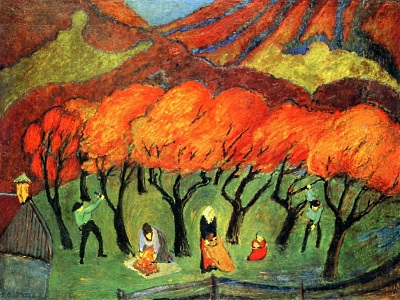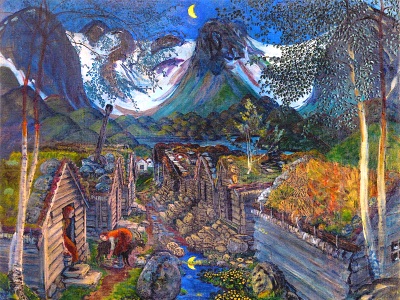In this address from 1921, Arnold speaks of the church as a living organism: a dynamic, changing, growing, and living body that reflects the communal order of the natural world. His metaphors draw on modern biology, and Arnold uses his knowledge in this area to emphasize the necessity of community not only for plants and animals, but for women and men as well.
Community presupposes life. We know that life is community of life, and that there is no life that is not living community. We can see this clearly from the community the hermit crab enjoys with the sea urchin in the depths of the sea. These remarkable crabs have soft and sensitive backs, and so defend themselves by crawling into the shell of a dead snail. But even there they are not yet safe from the polyps, those extraordinarily dangerous and ravenous creatures of the deep sea, which can pull them out of their shells with their tentacles. So the hermit crab forms a settlement community with the urchin, which fastens itself to the snail shell in which the crab lives. This urchin, with its prickly arms, clutches the whole shell so firmly that it seems almost impossible to loosen it. Thus the urchin protects the hermit crab from danger.
The crab also contributes to this mutual relationship. It provides mobility for the otherwise stationary urchin, allowing it to catch any prey that might cross the path of the wandering crab. Each creature shares its surplus with the other. These two creatures arise from such irreconcilably different genera that no sexual relationship could ever exist between them. Yet from time immemorial, they have represented a relationship of life as community and community as work.
But we do not need to descend into the depths of the sea to see other examples of the same kind of thing. In the mountains, for example, we can find the lichens: fungi that live in community with algae. These two very different plants are unable to live without each other. Only in community are they capable of life.
On a different level, colonies of ants or bees live in a primitive and yet powerful common life, sacrificing themselves as workers to provide for the propagation of the greater colony by the queen. These insects show us humans something which, in our desire for progress, we have lost with miserable weakness: the social instinct for the context of life, and for the common challenge.
There are many other examples from the practical life of the animal world. But we do not need to look for extraordinary and interesting examples in the world of nature alone. There is also a church community of men and women on this earth! Humanity is of course divided; we have not yet arrived at earth-wide community. But the fact that this church community exists is reality. And if we want to understand life-community, the mystery of this emerging, growing church community must dawn on us.
This church has nothing to do with any denomination or sect. The mark of the emerging church and the coming kingdom is the building up of quiet, hidden life-relationships, beginning with tiny cells which constantly renew their relationships with each other, become organs and members, and then again become one in a single body.
This church cannot be brought about by authoritative decisions, laws, or regulations. No human effort can bring it into existence. No dictatorship can prepare for it or create it. It is far from anything our self-will can achieve – far from all the efforts of self-seeking, power-hungry people or groups. It can come only as a gift of the Creator’s spirit of love.
But for this very reason, we must guard against the false notion that God is a purely transcendental power, removed from matter and the stuff of this earth. The coming community of life will be a kingdom of work on this earth. Work will be the binding factor in the cells of human community. The only work we can do with our whole soul, work full of spirit and pulsing life, comes from love. And there is no love that does not get to work.
Love is work: practical, strenuous work of muscle and mind, heart and soul. The kingdom of love, therefore, must be a kingdom of work. Work, truly unselfish work, animated by the spirit of brotherliness, will be the mark of the future, the character of the humanity to be. Work as spirit, work as living reality, such as we all have lost; work as dedication in enthusiastic love of togetherness – that is the fundamental character of the future. Joy in togetherness will show as joy in work.
How infinitely remote present-day humankind is from work like this! And since today we have only a faint conception of the possibility of this common life, we will be troubled again and again by pessimism, like a shadow from the abyss.
But we do know that it is not some fantastic, unattainable future; on the contrary, it is the quiet reality of a church already emerging today. God is – everywhere and always. We cannot make the kingdom of God – that is impossible – but we can live in God’s kingdom all the time. Christ comes to us. And as certainly as this is true for individuals, it will be fulfilled as fact for the whole world.
We are on a rope stretched tautly between two worlds. Let us walk out on this rope toward the land for which we long! If we believe this kingdom is approaching, if we are sure of this final transformation of all things, then let us live now in accordance with the spirit of this future.
Just this is the mystery of the emerging church, germinating and blossoming among us in secret – that we can live and work already now, here and everywhere, in the community of the Spirit. Faith in God and faith in Christ is the power that makes this possible. Where alienation and hostility prevailed, people will find the relationship to one another which is community.
Adapted from Johann Christoph Arnold, ed. Eberhard Arnold, Modern Spiritual Masters (Rifton, NY: Plough, 2011). The original document can be viewed in our digital archive: "Community and the Future of Work," manuscript, 1920.


